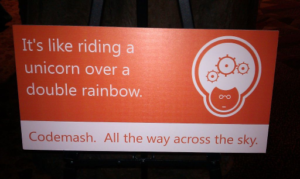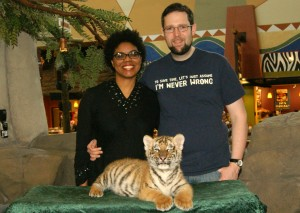
I went to CodeMash this year. I was one of the 1200 (or 1300 and something, after speakers and other people were counted). It was my first time attending this community-organised conference and I had a thoroughly enjoyable time. I would show you pictures but I neglected to take any as I was having far too good a time to remember that I'd brought a camera.
My wife and I1 arrived at the venue, the Kalahari Waterpark and Resort on Tuesday, the day before everything started with Wednesday's pre-compiler. Tuesday evening was spent meeting fellow mashers in the two resort bars, but ultimately led to a rocky start to Wednesday (breakfast was scheduled for 7am but I had forgotten to schedule bedtime accordingly).

At every meal during CodeMash, I enjoyed great food, nerdy conversation and copious quantities of caffeinated beverages with some fascinating people. Most of the time I dined with people I had never met, being sure to introduce myself and making a concerted effort to remember names (though, alas, I forgot a few). Although the pre-compiler day was overshadowed by a number of beverage-related issues varying from no coffee to no Mountain Dew to lots of coffee but no coffee cups (I improvised2), the remainder of the conference catering seemed to go without a hitch. This was in no doubt thanks to the CodeMash organizers and the amazing Kalahari staff.
Every evening after the sessions ended, a copious number of tempting options were available from the game rooms where D&D, poker and various other pastimes were enjoyed to Open Spaces3, from the bars, restaurants and water park to panel discussions. Attendees and CodeMash organizers alike would advertise a plethora of options to while away the hours until sleep was the only option. I was so exhausted after CodeMash that I slept for nearly a day when I got home.
What about the sessions themselves?
Wednesday
Going Independent
I'm not going independent, at least not anytime soon, but considering I have worked with many who are self-employed and might consider it for myself one day, it seemed prudent to learn more. Michael Eaton (@mjeaton) was the speaker for this session. He drew from personal experience and the experiences of those he knew (some of whom provided their own anecdotes) to outline the common practices and pitfalls that beset anyone trying to go it alone.
Michael's conversational style provided a great start to the conference and the information presented gave me a fresh perspective on the overhead, sales and productivity concerns of a business owner (apparently, if you manage 30 billable hours per week, you're doing well). Even for someone under full-time employment like me, it provided useful details that will help me to continue supporting those who employ me.
HTML5 is here, and the Web will never be the same
Wednesday afternoon was spent with Brandon Sartrom (@BrandonSatrom) and Clark Sell (@csell5) learning all about markup, behavior and presentation with HTML5, javascript and CSS3. I am not a web developer, my acquaintance with HTML and its supporting technologies would probably make a professional sob, but this lab on the latest and greatest was fantastic. Each area of the HTML5 offering was presented with hands-on labs to sink ones teeth into. There was so much to cover that eventually time fell short, but I still have the labs on my desktop and be assured, I intend to complete them. This was a great stuff and the session so popular that we had to move rooms about an hour in. Apparently, this web stuff is a big deal. Who knew?
Thursday
Unlike the pre-compiler format of half-day and full-day workshops and discussions, the remainder of the conference was split into concurrent hour long presentations, open spaces, gaming and other activities. The sheer number of distractions was sometimes overwhelming, making the act of choosing a distraction in itself to the point where a couple of times, I gave up and just took an hour long break.
On Thursday, we had our first keynote speech, Rethinking Enterprise, while munching away at the remnants of breakfast. The speaker, Ted Neward, had an energy that made sure everyone was awake. Although Ted's presentation style was ultimately controversial, I felt the points he made were valid, well thought out and thoroughly enjoyable to learn.
From the keynote, I swiftly headed to see the popular double-act of Jon Skeet(@jonskeet) and Bill Wagner (@billwagner) presenting C# async inside and out. It was a packed out double session. Some only turned up for the much more complicated second session and I'm sure probably left very confused and scared of both C# and async. However, I loved it. Not only did I witness Jon Skeet's passion for C# first hand, but I also learned a lot (a useful mutable struct?).
After the Skeet/Wagner show, I took a break to check on my wife and make sure she was having a good time. I actually had to persuade her to make an appointment in the spa as she was perfectly happy eating homemade gumbo and watching bad daytime TV in the hotel room. Once I'd convinced her to spend some money in the spa (what did I do?!), I headed back down to learn about usability testing with Carol Smith (@carologic), attended a vendor session from Robert Half Technology, and then headed to David Giard (@DavidGiard) and his presentation on data visualization.
I have to say that while I enjoyed all the talks and workshops I attended, David Giard's presentation on data visualization was by far in the top two sessions I attended. Not only did Mr. Giard give a great talk while very much under the weather, but the examples of good and bad data visualizations he presented were useful and clear. I came away with a new found appreciation for graphs and charts, and a new found skepticism of those who create them and their motives.
Thursday was rounded out by dinner, the hilarious Pecha Kucha competition, live music, impromptu free beer in one of the hotel rooms and a late night water park party just for CodeMash attendees. At least, those were the things I attended; as always there was far more going on elsewhere in the resort if one was so inclined to attend.
Friday
Friday started slow. The night had once again taken it's toll but breakfast was thankfully an hour later, which helped. I skipped the first session, opting instead to wander the vendor stands and show my appreciation for their support.
My first session of the day was Dealing with Information Overload delivered by Scott Hanselman. I really wanted to catch one of Scott's two presentations as I had seen him present at the San Francisco StackOverflow DevDays and really enjoyed his presentation style. Just as at DevDays in 2009, Scott gave a very enjoyable presentation packed with useful, necessary tips, tricks and lessons in how to deal with information and stay productive. I have already started to fold some of the techniques into my working day and intend to continue. Along with the Data Visualization presentation from Thursday, Dealing with Information Overload was in my top two talks of the conference.
Lunch followed with our second keynote speech, How We Got Here, And What To Do About It presented by Barry Hawkins. The keynote was excellent and the presenter only went up in my estimation when we spoke and I learned he was both an anglophile and a thoroughly nice chap4.
As lunch digested, I rounded out the conference with some C# Stunt Coding from Bill Wagner (and a little Jon Skeet when he got up to refactor Bill's code; thoroughly entertaining) and some applied F# from the crazy-shirted Gary Short (@garyshort). Both of these talks were wonderful and gave me some inspiration for some crazy and not so crazy things to try in the near future (both code- and fashion-based).
Friday night's raffle was entertaining, but I didn't win so I'm not saying anymore about it. I'm not bitter, but seriously, didn't win. I did, however, win a book from O'Reilly (@oreillymedia) just for singing a couple of lines to a song. O'Reilly had a large collection of books with them on their vendor booth and gave them all away to anyone willing to sing on video. I haven't seen that video surface yet, but I'm sure it will. Still, I now have a spanking new copy of Programming Android and they're not getting it back if they decide they don't like my pipes (but seriously, thanks for the book).
The End

And that was that. There was more partying and water park fun but the mashing was over. My wife and I enjoyed the remainder of our stay, including a few photos with Jafar, the Bengal tiger and then travelled home to pass out and catch up on sleep.
Congratulations to all who helped put this together and a hearty thanks to all the folks (speakers, staff, attendees and Jafar) that made my CodeMash experience. It was such a wonderful event to have been a part of and I hope I am fortunate enough to get a ticket next year.
- Yes, I took the missus. While I was learning and networking and totally not eating too much bacon or drinking, she was cooing at a Bengal Tiger cub or doing spa type things. [↩]
- Okay, so I took at least one photo. [↩]
- Open Spaces are free-form discussions on topics suggested by attendees where an open exchange of ideas, experiences, tips and other things can occur. [↩]
- My assessment and conclusion of the latter was in no way swayed by learning the former…I swear. [↩]
